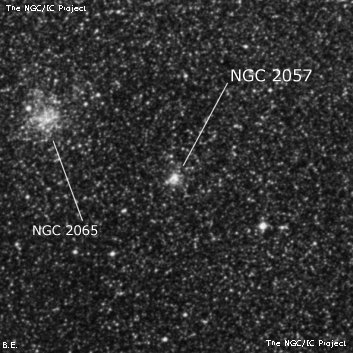
James Dunlop probably discovered NGC 2057 = D 104? on 24 Sep 1826 and described "a very small faint nebula, 8" or 10" diameter." He made a single observation and his position is 11' SE of this cluster. Assuming Dunlop also picked up NGC 2057 = D 104 and NGC 2065 = D 105, this identification is reasonable. John Herschel independently discovered NGC 2057 = h2935 on 11 Nov 1836 and recorded "pF; S; R; gbM; the 5th (4th properly) of a group of 6, RA only estimated from a rough diagram incorrect (as it would seem) in the order of the objects."
The entire group of clusters (NGC 2046, 2047, 2057, 2058, 2059, 2065, 2066) was sketched by Le Sueur, Joseph Turner and Pietro Baracchi in 1870, 1876 and 1884 using the 48" Great Melbourne Telescope. Le Sueur's sketch was reproduced as plate IV, figure 32 and Turner's sketch in plate IV, figure 33 in in "Observations of Southern Nebulae made with the Great Melbourne Telescope 1869 - 1885". Turner's sketch shows a star or clump bulging out the southeast side, though Baracchi's sketch shows a narrow extension to the north towards a faint star.
600/800mm - 24" (4/9/08 - Magellan Observatory, Australia): this LMC cluster is on the south side of a field filled with 8 NGC clusters. At 260x it appeared bright, fairly small, round, ~30" diameter, fairly well concentrated with a small bright core. Situated on a line between NGC 2065 4' NE and a mag 10.4 HD 269839 3' SW. NGC 2046 lies 6.8' WNW, 2047 7.0' NW and 2058 6.4' N.
Notes by Steve Gottlieb